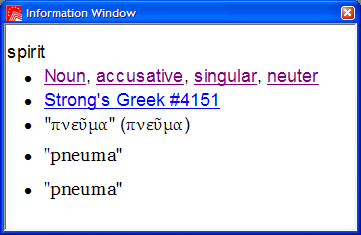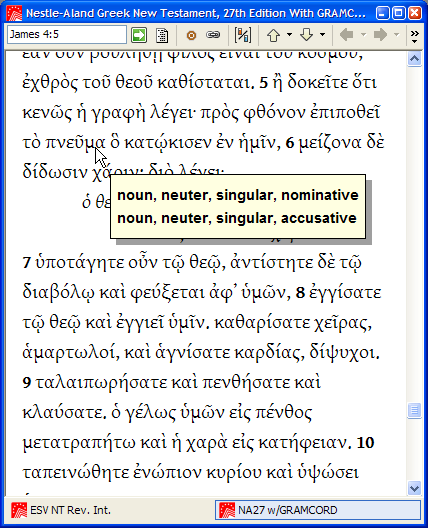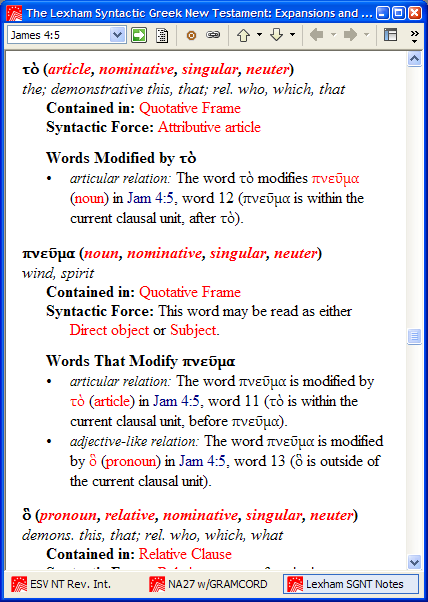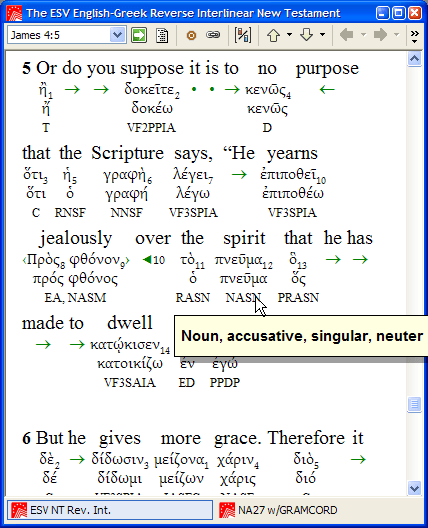Earlier I blogged on using multiple English translations to see how a passage is translated differently. In passages (such as James 4.5-6) where there are ambiguities, many times comparing English translations can help in understanding the best way to deal with the ambiguity.
With James 4.5, as we saw, translations are fairly evenly split in handling this passage. Recall the issues:
- Is it ‘spirit’ or ‘Spirit’?
- Is [Ss]pirit the subject or direct object of its clause?
The first point is determined largely by context and how one reads the text. This means it is important to determine whether [Ss]pirit is the subject or direct object because this may assist in determining whether it is ‘spirit’ or ‘Spirit’. This post digs into the second point above by digging down into the underlying Greek. Of course, this is problematic for the same reason: ambiguity.
ESV NT Reverse Interlinear
The ESV NT Reverse Interlinear has the ESV translation as its top-line text. It aligns the corresponding Greek text underneath. So it provides an easy way not only to get to the associated Greek word, but also to get to grammatical information (morphology) about the Greek word.
If we go to James 4.5 in the ESV NT Reverse Interlinear, we see the following:
James 4.5 in the ESV NT Reverse Interlinear
The ESV NT Reverse Interlinear uses Swanson’s Greek New Testament Morphology as the underlying Greek Morphology. In this case, ?? ?????? is parsed in the accusative case.
What does that mean? Well, if we right-click the Greek word and select “Display Information” we get a popup like the following:

Display Information content for ?????? in ESV NT Reverse Interlinear
Note that accusative is clickable. This means we can hover or click it to learn more about the word accusative. The definition comes from a glossary of morphological terminology. The definition is:
accusative The case that normally marks the direct object of a verb.
Heiser, M. S. (2005; 2005). Glossary of Morpho-Syntactic Database Terminology. Logos Bible Software.
So we know that this morphology considers ?????? to be accusative, thus to be the direct object of the verb of the clause. And this matches the ESV text.
But it isn’t necessarily this simple …
NA27 with GRAMCORD Morphology
It is always good to consult a second opinion, particularly when you’re confused. So we’ll next examine the NA27 Greek New Testament with GRAMCORD morphology. This is the same basic Greek text as that aligned with the ESV New Testament, but the morphological analysis is different.
GRAMCORD actually notes the ambiguity and provides two parsings for ??????. They say it is either nominative or accusative, as shown below:

James 4.5 in the NA27 with GRAMCORD morphology
We’ve learned a bit about what the accusative noun case indicates. What about the nominative case?
nominative The case that normally refers the subject of a verb.
Heiser, M. S. (2005; 2005). Glossary of Morpho-Syntactic Database Terminology. Logos Bible Software.
Now we can understand why English translations are all over the place: This instance is ambiguous, ?? ?????? can be declined in either the nominative case or the accusative case. One small hope, however, with the GRAMCORD morphology has to do with the order of morphological annotation where multiple annotations exist. In GRAMCORD, the first parsing is usually the one the editors prefer, the second is possible but, on the estimation of the editors, less likely. So in this case we can conclude that both are possible but, in the estimation of the editors of the GRAMCORD morphology, it is more likely a nominativeand thus more likely the subject of the clause.
Of course, this is against how the translators and editors of the ESV (and other English translations, as we found out in the previous post) translate this clause. So we’re still left in a bit of confusion. What next?
The Lexham Syntactic Greek New Testament (Lexham SGNT)
The Lexham SGNT is an in-progress syntactic analysis of the New Testament. Data has been released for James, so we can check and see what it says about ?? ??????. The best place to look is in the Lexham SGNT: Expansions and Annotations resource. This resource functions like a word-by-word syntactic commentary on the text, providing information about syntactic function and also information on how the current word relates to other words in its context. The below entry shows the information for both ?? and ??????:

?? ?????? in the Lexham SGNT Expansions and Annotations
As you can see, the entries tell us how ?? and ?????? relate to each other (one is an article that modifies the noun). We can also see the Syntactic Force of ??????, that it may be read as either Direct Object or Subject. Note that both of those terms are red, which means they can be clicked on or hovered for definitions or more information. These definitions have further references into Greek grammars. So, if you click “Direct Object” you can from there get into either BDF or Wallace for further information and extended discussion. This could help in understanding more what “Subject” and “Direct Object” entail, which will help in determining what’s going on in this passage.
A side note: Order of terms in the Syntactic Force notation is not significant, so in this case we cannot say that the editor considers it more likely that this is a direct object. The Lexham SGNT reports the options and provides links into further resources.
The OpenText.org Syntactically Analyzed Greek New Testament
OpenText.org decline ?? ?????? as accusative, but mark it as the subject of the clause containing the quotation. This is evident in viewing the graph annotation:
This is somewhat confusing as the morphology of OpenText.org declines the noun as accusative but annotates the phrase as the subject of the secondary clause. This inconsistency has been reported to the OpenText.org group for consideration.
Summary
Well, things are still ambiguous, though we’ve looked in a lot of places to try to disambiguate them. English translations are fairly evenly split. Some Greek morphologies make a decision, others provide options. Syntactic annotations are the same; some provide options while others make a decision. Both morphologies and syntactic annotations provide links to grammatical resources (grammatical glossaries, grammars) for further research.
Either way, it is plain that this is ambiguous, and reputable scholars (and translators, and editors) translate and interpret the text differently.
What are our options at this point? We could:
- See other ways that James uses ??????. This would involve searching for ?????? (or, perhaps, “spirit”) in James and examining how the word is used (Jas 2.26). This is not a sure-fire solution, but it is worth checking out.
- Do a Bible Word Study report on the verb ???????? and examine Grammatical Relationships to see how else it is used. What sorts of things does it take as subject? As object?
- Examine the larger context. Are there things present that would preclude one reading or the other? Are there things present that would lead you to prefer one over the other?
- Examine commentaries that you’re familiar with and see how they present the ambiguity. A good commentary won’t just tell you how you should handle this, it will also tell you why that way is the proper way. Even better commentaries will discuss all of the options and explain why (if?) one is better than the others.
Next in the series we’ll look at the quotation in verse 5 and ask about what the quotation is, and where it might come from.






